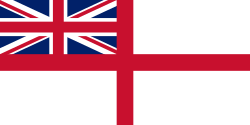Charlton
In 1842, a Compass Branch was established as part of the Hydrographic Department, [3] and a compass observatory was set up in a garden behind a house in Hawkins Terrace, off Maryon Road, Charlton, not far from the Royal Navy's Dockyard at Woolwich. [4] Captain Edward Johnson led the project and appointed a retired Scottish Artillery Sergeant, James Nathaniel Brunton to live in the house and tend the observatory. This was an octagonal wooden structure "rather like a summer house", which had to be free of iron. It had two shutters in the roof and three masonry pedestals to hold instruments. Two were used to determine true north; the other held compasses being tested. Johnson died in 1853 and Brunton continued to run the Observatory but never attained the rank of Acting Superintendent. [4]
Deptford
In 1869 Woolwich Dockyard closed, and the observatory was moved to the Naval Victualling Yard at Deptford. The Superintendent had his residence and office on the site (above which he maintained a small museum, containing 'the first water-compass, made by a Feversham optician, and [...] a number of compasses which have been on Polar expeditions, or round the world with the Challenger'). [1] The observatory building itself had been transferred to the site from Charlton, together with the associated equipment. The simple wooden structure, around 15 ft (4.6 m) in diameter, stood in the central open square of the victualling establishment. No iron was permitted in or near the building. Brunton continued in his role at Deptford but stayed in the Maryon Road house for another year after which he was given a lodging allowance; in 1871 he was living in The Terrace at Deptford Dockyard and was Assistant Superintendent of Compasses. He eventually was forced to retire, aged over 80, in 1883. [4]
In 1895, Arthur Quiller-Couch described the operation of the observatory on a visit to the establishment:
'Within the room are three stone pillars in line with a mark on a wall outside, and 110 feet away. The compass to be tested is placed on the first table, and its bearing ascertained by aligning sights upon this mark. On the second table is a telescopic sight, by which the movements of a very delicate magnet on the third table can be ascertained. The degrees of variation for Deptford (usually about 17°) can be read of a scale and correction applied'. [1]
After testing ashore, the compass was then tested again aboard its ship, which was moored (usually off Greenhithe) and swung on its moorings through all points of the compass, with bearings being taken on a fixed landmark ashore. Other forms of testing were also routinely employed. Ships compasses were tested in this way at Deptford every three to four years. Further to this, the Superintendent received regular reports 'from every British war-ship in every corner of the world'. [1] Compasses for use on smaller vessels such as rowing boats, where less precision was required, were also tested on site, but using smaller-scale equipment in the Superintendent's office. [1]
In 1911, the Compass Branch was removed from the Department of the Hydrographer of the Navy, and affiliated instead to the Controller of the Navy's Department; at the same time its work in connection with terrestrial magnetism was transferred to the Royal Observatory Greenwich.
